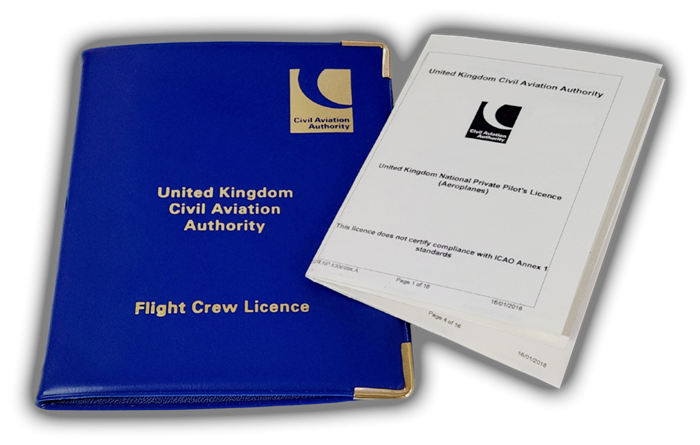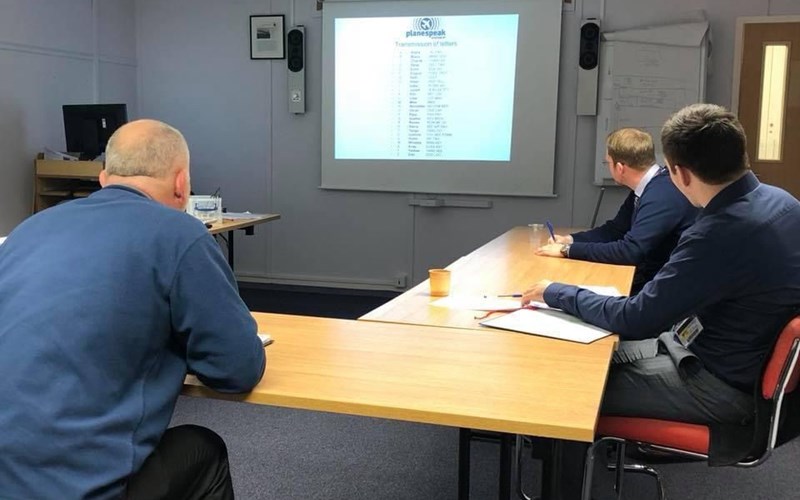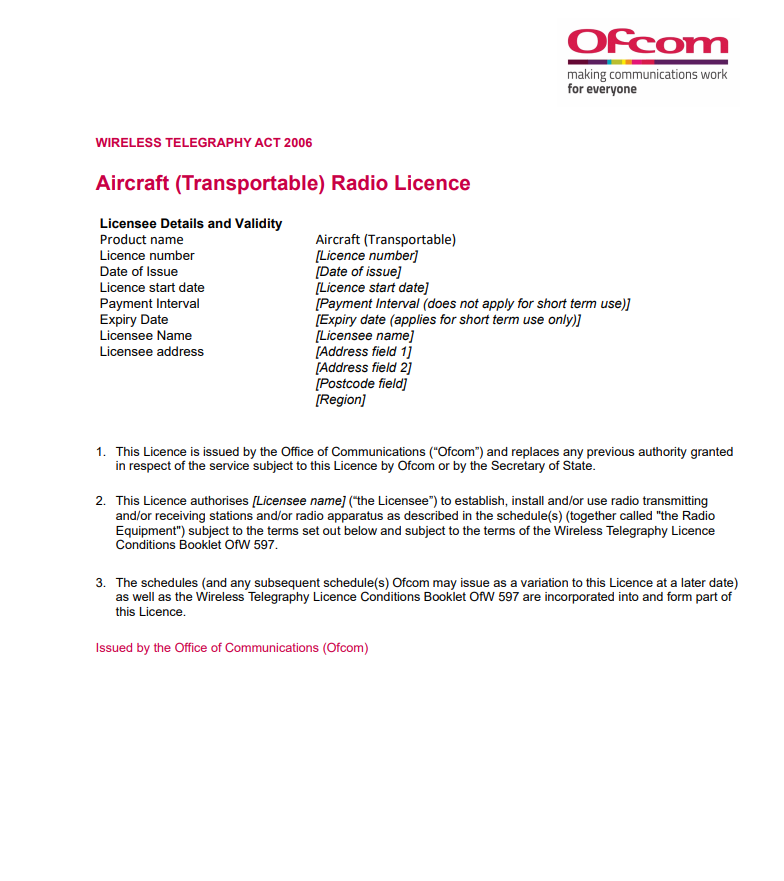The FRTOL Licence & Exam
Everything you REALLY need to know about the Flight Radiotelephony Operator's Licence (FRTOL).

FLIGHT RADIOTELEPHONY OPERATOR'S LICENCE
What is the FRTOL Licence?
The Flight RadioTelephony Operator's Licence (FRTOL) is a licence that is issued to flight crew and other persons who have a requirement to operate the Aircraft Radio Station in a UK registered aircraft.
The FRTOL is a national licence that may be printed onto a UK-issued Flight Crew Licence, or separately.
The requirement to have a licence for a radio station in an aircraft and to be licensed or otherwise permitted to operate that radio station is detailed in Article 112 of the Air Navigation Order (ANO).
Articles 50 and 50A of the ANO specify that an FRTOL is required in order to act as a radiotelephony operator in UK registered aircraft.
There are exceptions for flight crew under training and for sailplane pilots when transmitting on frequencies specifically allocated for glider operation.
No person may operate an aircraft radio station in the air, or on the ground, unless they are in possession of a valid FRTOL, or are operating directly under the supervision of the holder of a FRTOL. This applies equally to ground crew and other persons who wish to operate radio transmitting equipment licensed in accordance with, and operating on, frequencies listed in the Aircraft Radio Licence.
The FRTOL is a national (UK) licence that may be issued as a stand-alone licence. However, in most cases the FRTOL is held in conjunction with another Flight Crew licence, such as a UK National Private Pilot's Licence (NPPL).
FRTOL LEGISLATION
What does the law say about the FRTOL?
The FRTOL provides no privileges for the installation or establishment of a Radio Station; it is an operator's licence.
The FRTOL does not entitle the holder to operate a radio station installed anywhere other than in an aircraft. All aeronautical and aircraft radio stations require a Radio Licence issued by the CAA in accordance with the Wireless Telegraphy Acts as amended.
The holder of a FRTOL is responsible for ensuring that the aircraft radio station they operate has a valid radio licence. Failure to do so will render them liable to prosecution under the Wireless Telegraphy Acts.
In the UK, radio use is governed by both primary legislation (Acts of Parliament) and secondary legislation (Statutory Instruments made under the Acts). Ofcom manages the radio spectrum within a statutory framework created by the Communications Act 2003 (the 'Communications Act')1 and the WT Act. These Acts set out duties, functions and powers while allowing for Government to direct Ofcom on how to carry out our spectrum functions.
Ofcom's role in aeronautical licensing is to administer and issue licences. They will also collect licence fees, issue fee notices and send out reminders if payment date is missed. The CAA will continue to assign and coordinate frequencies. The CAA will continue to assess stations are fit for purpose under the ANO procedures and approve equipment.
FRTOL ISSUANCE
How do I get my FRTOL?
In order to obtain a FRTOL, candidates must sit the multiple-choice PPL Communications paper (written exam) and a FRTOL Practical Test (oral exam). There is also a requirement to hold an English Language proficiency of level 4 or greater to be issued with a FRTOL.
FRTOL written exam
The FRTOL written exam is made up of 12 multiple-choice questions, and cover all aspects of radiotelephony, including procedures and equipment.
There are six main areas that make up the FRTOL syllabus, and cover procedures, regulations and advice regarding:
- Aircraft Radio Equipment
- General Phraseology, References & Procedures
- Departure Procedures
- Arrival & Circuit Procedures
- Enroute Procedures
- Emergency, Abnormal & Lost Procedures
It is crucial that candidates requiring a FRTOL revise and practice each area of the syllabus thoroughly (using Wilco Radio) before attempting the exam.

Candidates sitting the FRTOL written examination at Planespeak Aviation RT
FRTOL oral exam
The second examination is the FRTOL Practical Test - an oral exam with a CAA-approved examiner, held in-person, usually at their premises.
This exam uses two-way radios, where you will be required to communicate with the examiner (sat in another room), using procedures that you have learned in the FRTOL syllabus.
The examiner will take on the role of air traffic services (e.g. air traffic control, or flight information services officer), and the candidate takes the role of the pilot.
After 30 minutes of preparation, you will be required to communicate with the examiner throughout a pre-written route, which will include aerodrome departure, enroute procedures (such as Mayday calls), MATZ transits, and aerodrome arrival.
The exam can take anywhere between 30-60 minutes to complete. After the oral exam, your examiner will tell you whether you have passed your oral exam.
Studying for both exams is essential, due to the complexity of the radiotelephony procedures that you'll use as a pilot. Candidates wishing to pass their FRTOL are advised to spend at least 10 hours learning and practicing the procedures.
Wilco Radio was built specifically for this purpose. Not only are you able to learn the correct radio procedures as set out in CAP413 and the CAA's SRG1171 syllabus, you also have access to practice test routes and the innovative Interactive Trainer, which allows you to practice RT with an Artificially-Intelligent "Bot".
RADIO EQUIPMENT
What radio equipment does the FRTOL cover?
The FRTOL is issued to flight crew that have a requirement to use radio equipment in an aircraft, including hand-held and built-in transceiver radios such as the Garmin GTR 200, Trig TY, and Motorola two-way radios.
Why are radios used?
An aircraft transceiver is a radio (hand-held or built-in) that gives pilots two-way communication with Air Traffic Services (ATS).
They are used primarily for safety and navigation purposes, so that pilots, ATS, and ground personnel can communicate with each other, using clear concise standardised phraseology.
Radios provide all airspace users with guidance and reassurance, and are responsible for saving many lives each year across the world.
What is an aircraft transceiver?
The word 'transceiver' is a combination of 'transmitter' and 'receiver'. It can both transmit and receive radio waves using an antenna, for communication purposes, combined into a single device for ease of use.
Transceivers operate on VHF "airband" frequencies between 108 and 137 MHz, and channels are divided into 8.33 kHz channel spacing, permitting up to 2,280 channels which are used for commercial, search and rescue, military, glider/balloon, flight test and general aviation use.

An Aircraft Radio Licence as issued by Ofcom
BEFORE YOU TAKE YOUR TEST
FRTOL requirements
The CAA sets out a number of requirements that you need to meet before applying for your FRTOL. These are as follows:
You must:
- Be a minimum of 14 years of age
- Pass the PPC Communications theoretical exam (this must be completed before the practical exam, and a 24-month validity period applies for the licence issue)
- Pass a Radio Telephony practical test (24 month validity period applies for licence issue)
- Demonstrate an English Language Proficiency (ELP) to Level 4, 5, or 6, which must be valid on the date that the FRTOL is issued.
How to apply for your FRTOL
If you have signed up with Wilco Radio, then you will be awarded a pre-completed SRG1105 form to be submitted to the CAA.
If you have not joined Wilco Radio, you will need to manually complete and submit the SRG1105 form. This can be done through the CAA website.
Examination validity
If you take the Radiotelephony Communications test together with the theoretical exams for the issue of a PPL, LAPL or NPPL licence all exams must be passed within an 18 month period.
The Communications examination will then be valid for 24 months following the final theoretical examination.
Learn CAP413 radiotelephony... fast
Pass your FRTOL exams with flying colours
Combining expert subject matter and the latest in speech synthesis technology, Wilco Radio helps you prepare for your Flight Radiotelephony Operator's Licence in the comfort of your own home.
Our course syllabus follows the latest version of the CAA's CAP413 Radiotelephony Manual. Rest assured, you can be certain that you are learning up-to-date radiotelephony procedures that follow official guidelines.
On completion, you'll be awarded a Certificate of Completion and completed SRG1171 form (FRTOL Record of Completion) to hand to your FRTOL examiner as proof that you have the necessary knowledge to take the exam.

